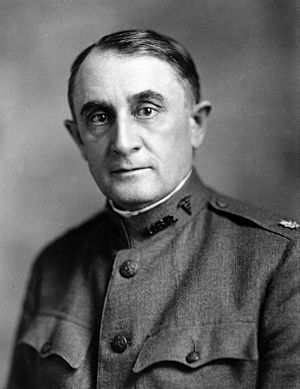Charles Horace Mayo facts for kids
Quick facts for kids
Charles Horace Mayo
|
|
|---|---|
 |
|
| Born | July 19, 1865 Rochester, Minnesota, U.S.
|
| Died | May 26, 1939 (aged 73) |
| Alma mater | Northwestern University (MD) |
| Known for | Founding of the Mayo Clinic |
| Scientific career | |
| Fields | Medicine, surgery |
Charles Horace Mayo (born July 19, 1865 – died May 26, 1939) was an important American doctor. He helped start the famous Mayo Clinic with his brother, William James Mayo, and several other doctors.
Starting the Mayo Clinic
Charles Mayo earned his medical degree from Northwestern University in 1888. After more studies, he joined his father, William Worrall Mayo, and older brother, William James Mayo, in their private medical practice. This practice was in Rochester, Minnesota.
The Mayo family's first partner was Augustus Stinchfield. After Augustus joined, their father, W. W. Mayo, retired. In 1919, their private practice became the not-for-profit Mayo Clinic. This meant it was no longer just a family business but a large, organized medical center.
The Mayo Clinic became one of the best places in the world for medical treatment and research. During Charles Mayo's lifetime, over one million patients visited the clinic.
New Ideas in Medicine
The doctors at the Mayo Clinic were pioneers in medical specialization. This means they believed doctors should focus on specific areas of medicine. For example, Charles H. Mayo became an expert in surgery of the thyroid gland and the nervous system.
He also cared for patients with eye problems until 1908. Charles and his early partners insisted on very clean conditions in the operating room. This was a new idea at the time and helped make their surgeries very successful.
Charles H. Mayo was very active in many medical groups. He was president of several important associations. These included the Western Surgical Association and the American Medical Association.
During World War I, Charles and his brother were top surgical advisors for the U.S. Army. He became a brigadier general in the Army Medical Department. From 1919 until he retired in 1936, he was also a professor of surgery at the University of Minnesota.
His Family Life
Charles Mayo married Edith Graham in 1893. He was part of the Episcopal church and was involved in many community groups.
Charles Mayo retired in 1930. He passed away in 1939 in Chicago, Illinois, from pneumonia. His two sons, Charles William Mayo and Joseph Graham Mayo, also worked at the Mayo Clinic. Sadly, Joseph Graham Mayo died in an accident in 1936. A grandson, Charles Horace Mayo II, later worked at the clinic too.
Awards and Honors
Charles Mayo received many honors during his life and after his death:
- Army Distinguished Service Medal (1920)
- Officer of the Legion of Honour from France (1925)
- Officer of the Order of Public Instruction from France (1925)
- Officer of the Order of Arts and Letters from France (1925)
- Commander of the Order of the Crown of Italy (1932)
- In 1964, the United States Postal Service released a stamp showing Charles Horace Mayo and his brother.
See also
 In Spanish: Charles Horace Mayo para niños
In Spanish: Charles Horace Mayo para niños



